The American Association for Access, Equity and Diversity (AAAED):
WHAT IS AFFIRMATIVE ACTION?
In its Final Report to President Eisenhower, the President's Committee on Government Contracts, headed by Vice President Richard Nixon, concluded:
Overt discrimination, in the sense that an employer actually refuses to hire solely because of race, religion, color, or national origin is not as prevalent as is generally believed. To a greater degree, the indifference of employers to establishing a positive policy of nondiscrimination hinders qualified applicants and employees from being hired and promoted on the basis of equality.
President Kennedy incorporated the concept of “affirmative action” into Executive Order 10925, which he issued in 1961. Executive Order 10925 imposed on all covered contractors a general obligation requiring positive steps designed to overcome obstacles to equal employment opportunity.
In 1965, President Lyndon Baines Johnson signed Executive Order 11246, which gave the Secretary of Labor responsibility for administration and enforcement of the Order mandating that contractors not discriminate against any employees or qualified applicants because of race, color, religion, sex or national origin. Contractors were to take affirmative action to ensure nondiscrimination in employment, upgrading, demotion or transfer, recruitment or recruitment advertising, layoff or termination, rates of pay or other forms of compensation, and selection for training, including apprenticeship.

Before signing the order in September 1965, President Johnson uttered the words that continue to resonate today during his speech at Howard University’s Commencement, June 4, 1965: Freedom is not enough. … You do not take a person who, for years, has been hobbled by chains and liberate him, bring him up to the starting line of a race and then say, “You are free to compete with all the others,” and still justly believe that you have been completely fair.
The quest for equality as a right and as a result has taken more than 50 years. It has faced much success, as evidenced in the marked increases of women and persons of color in private industry, in government, and in the Academy. It has also faced considerable challenges, rhetorical and legal, waxing in certain presidential administrations, waning in others.
Affirmative action itself has been defined as "any measure, beyond simple termination of a discriminatory practice, adopted to correct or compensate for past or present discrimination or to prevent discrimination from recurring in the future." (U.S. Commission on Civil Rights, Statement on Affirmative Action, October 1977.)
Affirmative action has varying definitions depending upon the sector in which it is found, e.g., education, government contracting and employment. Executive Order 11246 and its regulations refer to a process that requires a government contractor to examine and evaluate the total scope of its personnel practices for the purpose of identifying and correcting any barriers to equal employment opportunity. Where problems are identified, the contractor is required to develop a program that is precisely tailored to correct the deficiencies. Where appropriate, the contractor is required to establish reasonable goals to measure success toward achieving that result. The affirmative action program incorporated in the regulations has its origins in the private sector, where contractor “Plans for Progress” were reportedly designed to take positive action and prevent discrimination lawsuits.
Affirmative action programs encompass more than outreach and recruitment, however, and include efforts to prevent discrimination by eliminating barriers to equal employment opportunity. The inverse relationship between affirmative action and discrimination is reflected in the Executive Order itself, which begins with a prohibition against discrimination. In essence, affirmative action creates an environment where equal employment opportunity can prevail. Affirmative action, especially as it is mandated in employment discrimination litigation, is also compensatory and serves to remedy the effects of past discrimination.
Affirmative action therefore means taking positive steps to end discrimination, to prevent its recurrence, and to create new opportunities that were previously denied minorities and women.
Affirmative action has been criticized as constituting reverse discrimination, preferential treatment, stigmatizing to beneficiaries and contravening principles of merit. Spearheaded by these organizations voters in the states of California, Washington, Michigan, Nebraska and Arizona have passed initiatives to prohibit affirmative action.
What Affirmative Action Isn’t:
Quotas
Preferential Treatment
Guaranteed Results
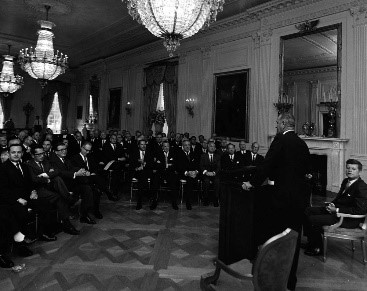
Presidents Johnson and Kennedy meet with business leaders
Q's & A's ON AFFIRMATIVE ACTION
WHAT ARE THE PRIMARY COMPONENTS OF A WRITTEN AFFIRMATIVE ACTION PROGRAM?
Problem identification, Self-Analysis and Action-Oriented Programs. Under Executive Order 11246, contractors ($50K in contracts/50 employees) are required to identify barriers to equal employment opportunity and eliminate them through action-oriented programs. Where there are fewer women or minorities than would be reasonably expected, the employer has to establish goals.
ARE GOALS INTENDED TO ACHIEVE PROPORTIONAL REPRESENTATION OR EQUAL RESULTS?
Not at all. Numerical goals do not create guarantees for specific groups or preferences, nor are they designed to achieve proportional representation or equal results.
DOES AFFIRMATIVE ACTION UNDER EXECUTIVE ORDER 11246 REQUIRE EMPLOYERS TO HIRE OR PROMOTE WOMEN OR MINORITIES ON THE BASIS OF RACE OR SEX?
Absolutely not. No requirement exists that any specific position be filled by a person of a particular race, gender or ethnicity. By casting a wider net and recruiting a diverse pool of qualified individuals, an affirmative action employer eliminates preferences and levels the playing field for all. The essence of affirmative action is opportunity.
DOES AFFIRMATIVE ACTION UNDER EXECUTIVE ORDER 11246 CONFLICT WITH THE PRINCIPLES OF MERIT?
No. In seeking to achieve its goals, an employer is never required to hire a person who does not have the qualifications needed to perform the job successfully. Affirmative action prevents discrimination; it does not cause it.
SHOULD GOALS BE TREATED AS A CEILING OR A FLOOR?
Neither. The Executive Order does not require that contractors treat goals as either a ceiling or a floor for the employment of particular groups.
WHAT IS THE STANDARD FOR COMPLIANCE UNDER THE EXECUTIVE ORDER?
The standard is and has always been "good faith effort."
ISN'T AFFIRMATIVE ACTION ONLY A RACE ISSUE?
No. Affirmative Action Programs benefit women, persons with disabilities and veterans as well.
BACKGROUND
President Johnson's speech eloquently articulated the rationale behind the contemporary use of affirmative action programs to achieve equal opportunity, especially in the fields of employment and higher education.
The emphasis is on opportunity: affirmative action programs are meant to break down barriers, both visible and invisible, to level the playing field, and to make sure everyone is given an equal break. They are not meant to guarantee equal results -- but instead proceed on the common-sense notion that if equality of opportunity were a reality, African Americans, women, people with disabilities and other groups facing discrimination would be fairly represented in the nation's work force and educational institutions.
The debate over affirmative action demarcates a philosophical divide, separating those with sharply different views of the "American dilemma" -- how the nation should treat African Americans, other people of color and women. This division centers on a number of questions: to what extent discrimination and bias persist, especially in a systemic way; to what degree affirmative action programs have been effective in providing otherwise unavailable opportunities in education, employment, and business; and to what extent affirmative action programs appear to unduly benefit African Americans and other people of color at the expense of the white majority.
The continuing need for affirmative action is demonstrated by the data. For example, the National Asian and Pacific American Legal Consortium reported that although white men make up only 48% of the college-educated workforce, they hold over 90% of the top jobs in the news media, 96% of CEO positions, 86% of law firm partnerships, and 85% of tenured college faculty positions. In Fiscal Year 2014 there were 88,778 charges of discrimination filed with the Equal Employment Opportunity Commission: race charges were 35.0% of the total filed; sex, 29.3%; national origin, 10.8%; religion, 4.0%; color, 3.1%; retaliation, all statutes, 42.8%; age, 23.2%; and disability, 28.6%.
According to Diversity in Higher Education.com: Minority representation in faculty, administrators, and governing boards do not match minority representation in the student body:
• Student population: 35% minority
• Institution presidents: 14% minority
• Executive and administrative staff: 19% minority
• Full-time faculty: 22% minority
• Part-time faculty: 25% minority
• Governing board of public institutions: 22% minority
• Governing board of independent institutions: 12% minority
http://diversityinhighereducation.com/about-us/did-you-know/
Affirmative action is not, as some charge, a uniquely modern concept fashioned by contemporary liberals in defiance of history or tradition. Although the techniques that we now call "affirmative action" are of fairly recent design, the conceptual recognition of the need to take affirmative, or positive legal action to redress discrimination's impact, rather than simply ending discrimination, has been around since the Civil War.
During Reconstruction (the period immediately after the Civil War), the Constitution was amended and other federal initiatives, such as the creation of the Freedman's Bureau, were undertaken to establish equal opportunity for the former slaves. These initiatives were at least modestly successful, bringing about African-American participation in elections for the first time.
Sporadic efforts to remedy the results of hundreds of years of slavery, segregation and denial of opportunity have been made since the end of the Civil War. A significant number of African Americans held public office, including two U.S. senators and 20 members of the House, between 1870 and 1900. But when the federal government withdrew its support for Reconstruction in the late 1800s, the gains made by African Americans were quickly stripped away and replaced by a patchwork system of legal segregation (including, in some instances, legal segregation of Latinos, Asians, and Native Americans as well). By 1896, in Plessy v. Ferguson, the Supreme Court upheld the cornerstone segregationist doctrine of "separate but equal" - i.e., ruling that the Constitution permitted governments to require separation of the races in schools, public transportation, and elsewhere, so long as the opportunities offered the separate races were characterized as equal.
In the modern era, the concept of affirmative action was reborn on June 25, 1941, when President Franklin Roosevelt -- seeking to avert a march on Washington organized by civil rights pioneer A. Philip Randolph -- issued Executive Order 8802 requiring defense contractors to pledge nondiscrimination in employment in government-funded projects. Two years later, President Roosevelt extended coverage of the executive order to all federal contractors and subcontractors. In a 1947 report, the President's Committee on Fair Employment Practices found that, while African Americans comprised only three percent of the workers in defense industries in 1942, their number had increased to eight percent in 1945. But it also found "the wartime gains of Negro, Mexican-American and Jewish workers . . . began to disappear as soon as wartime controls were relaxed."
Successive presidents, under pressure from the African American community and civil rights advocates, continued the effort to increase minority employment opportunities and end job discrimination. It was not until President Kennedy issued Executive Order No. 10925, requiring not only that federal contractors pledge non-discrimination but that they "take affirmative action to ensure" equal opportunity, that the ultimately controversial phrase came into popular discourse.
Kennedy's order also included penalties -- including suspension of a contract -- for non-compliance. This was succeeded by another executive order (Executive Order 11246) issued by President Lyndon Johnson, along with the creation of the Office of Federal Contract Compliance in the Department of Labor to enforce its non-discrimination and affirmative action requirements. The Executive Order was amended in 1967 to include prohibitions on sex discrimination by federal contractors, along with a requirement that they engage in good faith efforts to expand job opportunities for women. Executive Order 11246 remains among the most effective and far-reaching federal programs for expanding equal opportunity.
Implementation of affirmative action started slowly, with the construction industry the site of one of the first tests. In 1965, the Office of Federal Contract Compliance created government-wide programs to redress the years of discrimination in the construction industry. The series of affirmative action programs was designed to boost minority employment by emphasizing hiring results in federally funded construction jobs.
In 1973 the Rehabilitation Act required federal agencies and contractors to take affirmative action in employment and promotion for people with disabilities. The Vietnam Era Veterans Readjustment Assistance Act of 1974 called for "the preferential employment of disabled veterans and veterans of the Vietnam era ... who are otherwise qualified." These changes underscored the use of affirmative action as a balancing of competitive interests. Affirmative action was understood to be the creation of opportunities to compete and not an assurance of success.
The various programs culminated in the "Philadelphia Plan," implemented under President Nixon. This plan required contractors doing business with the federal government to commit themselves to self-determined numerical goals for minorities. By withstanding challenges both in Congress and the courts, the Philadelphia Plan helped establish affirmative action as a way of life for American employers. Indeed, employers often embraced affirmative action as a good business practice, enabling them to tap into larger, more diverse, and more qualified pools of talent.
A key example of business support for affirmative action came early in Ronald Reagan's second term and from what would be considered a very unlikely source -- the conservative National Association of Manufacturers (NAM), which represented 13,500 companies. At issue was a split in the administration over proposals by President Reagan's most conservative appointees, including Attorney General Edwin Meese, to revise and weaken Executive Order 11246 by eliminating the use of affirmative action goals and timetables for minorities and women in the work force.
NAM, much to the surprise of the administration's conservatives, weighed in on behalf of keeping the executive order intact. In a letter to President Reagan, the business group said it "believes the current executive order provides the framework for an affirmative action policy" and argued that "the business community is concerned that the elimination of goals and timetables could result in confusing compliance standards on federal, state and municipal levels and a proliferation of reverse discrimination suits."
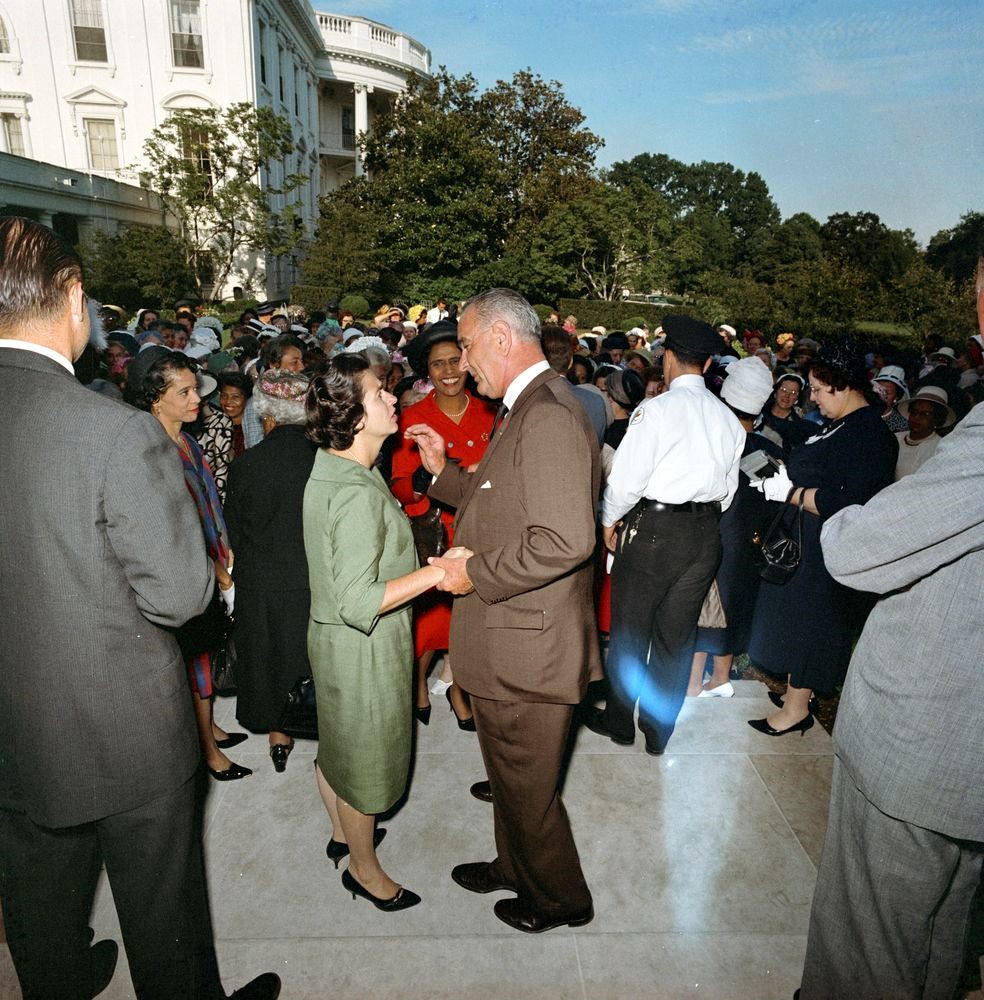
President Johnson meets with women's groups
SUCCESSIVE EXECUTIVE ORDERS ON CIVIL RIGHTS
E.O. 8802: President Franklin Roosevelt issues Executive Order 8802, which bans racial discrimination in any defense industry receiving federal contracts and established the Fair Employment Practices Committee to investigate such complaints.
EO 9346: In 1943, President Roosevelt broadened the coverage of Executive Order 8802 by making it applicable to all government contractors.
EO 10308: Nearly a decade later, on December 3, 1951, President Harry S. Truman's Executive Order 10308 advanced the achievements initiated during WWII by creating the Committee on Government Contract Compliance. The committee, as its name implies, was tasked with overseeing compliance by federal contractors with the non-discrimination provisions of Executive Order 8802.
EO 10479: President Dwight D. Eisenhower took a further step on August 13, 1953, by creating the President's Committee on Government Contracts under Executive Order 10479. This reorganization furthered the principle that "…it is the obligation of the contracting agencies of the United States Government and government contractors to insure compliance with, and successful execution of, the equal employment opportunity program of the United States Government."
This Executive Order made the head of each contracting agency of the federal government responsible for obtaining compliance by their contractors and subcontractors with the nondiscrimination provisions of the contracts into which they entered. Coordination would be provided by the President's Committee on Government Contracts, housed in the Department of Labor, and comprised of representatives of major contracting agencies, the Labor and Justice Departments, and the General Services Administration as well as eight Presidential appointees. The President designated the Committee's chair and vice chair.
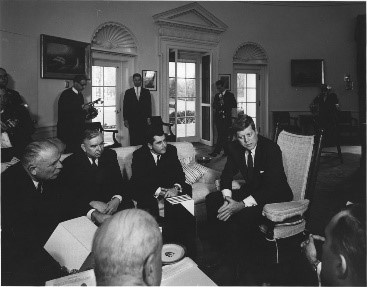
President Kennedy meets with civil rights leaders.
Executive Order 10925: By the time John F. Kennedy was elected President, it was evident that to advance equal employment opportunity federal involvement needed to be broader and more proactive. On March 6, 1961, shortly after JFK took office, he signed Executive Order 10925, opening a new chapter in achieving access to good jobs by requiring government contractors to "take affirmative action to ensure that applicants are employed, and that employees are treated during employment, without regard to their race, creed, color or national origin."
Executive Order 10925 gave federal contracting agencies authority to institute procedures against federal contractors who violated their EEO obligations-including contract cancellation, debarment from future contracts and other sanctions.
It also created the President's Committee on Equal Employment Opportunity, which upon passage of the Civil Rights Act in 1964 became the Equal Employment Opportunity Committee. The President's Committee was chaired by Vice President Lyndon Johnson and later by Vice President Hubert Humphrey. The Committee's vice chair was Secretary of Labor Willard Wirtz.
Executive Order 11246: President Johnson's vision of creating a "Great Society" led to a host of endeavors that sought to change the political, social and economic landscape of the U.S.
In his 1965 commencement address to graduates of Howard University, LBJ gave voice to his vision, declaring, "We seek not just freedom but opportunity. We seek not just legal equity but human ability, not just equality as a right and a theory but equality as a fact and equality as a result. “
On September 24, 1965, President Johnson signed Executive Order 11246, making the Secretary of Labor responsible for administering the order's non-discrimination and affirmative action provisions. Soon thereafter, Secretary of Labor Wirtz established the Office of Federal Contract Compliance. Edward C. Sylvester, Jr. was appointed as the agency's first director.
Today, Executive Order 11246, as amended and further strengthened over the years, remains a major safeguard, protecting the rights of workers employed by federal contractors-approximately one-fifth of the entire U.S. labor force-to remain free from discrimination on the basis of their gender, race, religion, color or national origin…and opening the doors of opportunity through its affirmative action provisions.
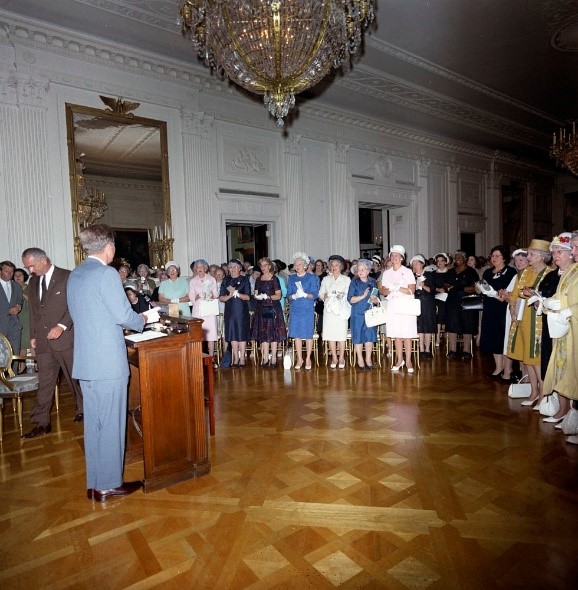
President Kennedy addresses organizations.
In 1967, President Johnson added “sex” to the list of prohibited bases. In 1969, the Nixon administration picked up a plan that the Johnson administration had put forth for the construction industry in the city of Philadelphia, referred to as the Philadelphia Plan. The Johnson administration plan was faulted for not having definite minimum standards for the required affirmative action programs. The Nixon plan did issue minimum standards—specific targets for minority employees in several trades. It did not require these minimum standards be met, simply that contractors submitting bids make a “good faith” effort to achieve these targets. This allowed the administration to argue it was not setting quotas, though critics of the plan suggested the administration was in fact doing so.
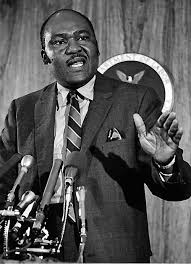
Assistant Labor Secretary Arthur Fletcher
The Philadelphia Plan, developed by Assistant Labor Secretary Arthur Fletcher during the Nixon Administration, survived several challenges, both legal and Congressional, before being accepted as legitimate. The Plan set the tone for affirmative action plans that followed. Soon, the standards put forth in the Philadelphia Plan were incorporated into Executive Order 11246 which affected all federal government contractors, who were required for the first time to put forth written affirmative action plans with numerical targets.
After the implementation of the Philadelphia Plan, legislation was passed at the federal, state, and municipal levels implementing affirmative action plans using the Philadelphia Plan as a model. Today, almost all government affirmative action plans are offshoots of the Philadelphia Plan. Its mixture of numerical targets and requirements of “good faith” effort was a milestone in the history of affirmative action. - See more at: http://civilrights.uslegal.com/affirmative-action/history-of-affirmative-action/#sthash.cdKmonbX.dpuf
TERMS IN THE DEBATE
An often-used -- and misused -- term in the lexicon of affirmative action is "quotas." President George Bush, for example, in vetoing the Civil Rights Bill of 1991, labeled it "a quota bill," and opponents of affirmative action use the word as a general pejorative to taint all race-conscious remedies for discrimination and efforts to prevent discrimination to promote equal opportunity. The courts, however, have provided a more accurate and precise definition: an absolute requirement that an employer hire a certain number of or percentage of employees from a specified group, without regard to the availability of qualified candidates or the presence of more qualified members of other groups. Such quotas are legally impermissible and are not a component of lawful affirmative action programs.
What affirmative action does sometimes involve is the establishment of a numerically expressed hiring goal, often in connection with a timetable. Indeed, as mentioned above, the Executive Order 11246 program covering federal contractors relies on the use of goals. Having established a goal, which is tied to the availability of qualified minority and women workers in the labor market, the employer pledges a "good faith" effort to achieve the goal. Failure to achieve the goal, however, does not, in and of itself, subject the employer to sanctions unless the affirmative action has been judicially ordered as a remedy to illegal discrimination. "Goals," the Citizens' Commission on Civil Rights has observed, "serve as one measure of nondiscrimination and of the effectiveness of affirmation action efforts, not as a mandate for minority or female employment." - See more at: http://civilrights.uslegal.com/affirmative-action/history-of-affirmative-action/#sthash.cdKmonbX.dpuf
The word “preferences” is also used to unfairly characterize affirmative action as a form of quotas. Ironically, affirmative action is used to eliminate the effects of preferences enjoyed by some for more than three centuries.
The state initiatives propounded by right-leaning organizations including the American Civil Rights Institute, led by California businessman Ward Connerly and formed as “a national civil rights organization created to educate the public on the harms of racial and gender preferences,” have peppered their ballot initiatives with the word “preferences.” Proposition 209, enacted in 1996 by a ballot initiative in California is titled:
PROHIBITION AGAINST DISCRIMINATION OR PREFERENTIAL
TREATMENT BY STATE AND OTHER PUBLIC ENTITIES.
INITIATIVE CONSTITUTIONAL AMENDMENT.
In a news release of the Leadership Conference on Civil Rights regarding the language used by the proponents of the Michigan Civil Rights Initiative in 2006, executive director Wade Henderson stated: "We oppose this deceptive initiative. We are disappointed that Connerly's word games are reflected in the ballot language, however, we are confident that Michigan voters, upon learning the intent of MCRI, will come out in droves to oppose the initiative." http://www.civilrights.org/press/2006/michigan-board-of-state-canvassers-approves-language-for-anti-affirmative-action-ballot-initiative.html
In 2000 the Department of Labor’s Office of Federal Contract Compliance Programs (OFCCP) amended its regulations to make clear that affirmative action goals were not quotas or any form of preferential treatment:
§60-2.16 Placement goals.
(a) Purpose: Placement goals serve as objectives or targets reasonably attainable by means of applying every good faith effort to make all aspects of the entire affirmative action program work. Placement goals also are used to measure progress toward achieving equal employment opportunity.
(b) A contractor's determination under §60-2.15 that a placement goal is required constitutes neither a finding nor an admission of discrimination.
(c) Where, pursuant to §60-2.15, a contractor is required to establish a placement goal for a particular job group, the contractor must establish a percentage annual placement goal at least equal to the availability figure derived for women or minorities, as appropriate, for that job group.
(d) The placement goal-setting process described above contemplates that contractors will, where required, establish a single goal for all minorities. In the event of a substantial disparity in the utilization of a particular minority group or in the utilization of men or women of a particular minority group, a contractor may be required to establish separate goals for those groups.
(e) In establishing placement goals, the following principles also apply:
(1) Placement goals may not be rigid and inflexible quotas, which must be met, nor are they to be considered as either a ceiling or a floor for the employment of particular groups. Quotas are expressly forbidden.
(2) In all employment decisions, the contractor must make selections in a nondiscriminatory manner. Placement goals do not provide the contractor with a justification to extend a preference to any individual, select an individual, or adversely affect an individual's employment status, on the basis of that person's race, color, religion, sex, sexual orientation, gender identity, or national origin.
(3) Placement goals do not create set-asides for specific groups, nor are they intended to achieve proportional representation or equal results.
(4) Placement goals may not be used to supersede merit selection principles. Affirmative action programs prescribed by the regulations in this part do not require a contractor to hire a person who lacks qualifications to perform the job successfully, or hire a less qualified person in preference to a more qualified one.
See the OFCCP regulations above at: http://www.ecfr.gov/cgi-bin/text-idx?c=ecfr&sid=3b71cb5b215c393fe910604d33c9fed1&rgn=div5&view=text&node=41:1.2.3.1.2&idno=41#se41.1.60_62_116idx?c=ecfr&sid=3b71cb5b215c393fe910604d33c9fed1&rgn=div5&view=text&node=41:1.2.3.1.2&idno=41#se41.1.60_62_116
 THE OFFICE OF FEDERAL CONTRACT COMPLIANCE PROGRAMS: U.S. DEPARTMENT OF LABOR
THE OFFICE OF FEDERAL CONTRACT COMPLIANCE PROGRAMS: U.S. DEPARTMENT OF LABOR
The Department of Labor's Office of Federal Contract Compliance Programs (OFCCP) enforces the Executive Order 11246, as amended; Section 503 of the Rehabilitation Act of 1973, as amended and the affirmative action provisions (Section 4212) of the Vietnam Era Veterans' Readjustment Assistance Act, as amended. Taken together, these laws ban discrimination and require Federal contractors and subcontractors to take affirmative action to ensure that all individuals have an equal opportunity for employment, without regard to race, color, religion, sex, national origin, disability or status as a Vietnam era or special disabled veteran. OFCCP’s jurisdiction covers approximately 26 million or nearly 22% of the total civilian workforce (92,500 non-construction establishments and 100,000 construction establishments). The Federal Government awarded more than $400 billion tax-payer dollars in prime contracts in Fiscal Year 2015.
OFCCP requires a contractor, as a condition of having a federal contract, to engage in a self-analysis for the purpose of discovering any barriers to equal employment opportunity. No other Government agency conducts comparable systemic reviews of employers’ employment practices to ferret out discrimination. OFCCP also investigates complaints of discrimination. In Fiscal Year 2013, OFCCP conducted approximately 4000 supply and service and construction contractor compliance evaluations. Moreover, OFCCP programs prevent discrimination. Further information about the OFCCP programs may be obtained from the agency’s website at www.dol.gov/ofccp.
OPERATION OF THE EXECUTIVE ORDER PROGRAM - THE EEO CLAUSE
Each contracting agency in the Executive Branch of government must include the equal opportunity clause in each of its nonexempt government contracts. The equal opportunity clause requires that the contractor will take affirmative action to ensure that applicants are employed, and that employees are treated during employment, without regard to their race, color, religion, sex or national origin. American Indian or Alaskan Native, Asian or Pacific Islander, Black, and Hispanic individuals are considered minorities for purposes of the Executive Order. This clause makes equal employment opportunity and affirmative action integral elements of a contractor’s agreement with the government. Failure to comply with the non-discrimination or affirmative action provisions is a violation of the contract.
A contractor in violation of E.O. 11246 may have its contracts canceled, terminated, or suspended in whole or in part, and the contractor may be debarred, i.e., declared ineligible for future government contracts. However, a contractor cannot be debarred without being afforded the opportunity for a full evidentiary hearing. Debarments may be for an indefinite term or for a fixed term. When an indefinite term debarment is imposed, the contractor may be reinstated as soon as it has demonstrated that the violations have been remedied. A fixed-term debarment establishes a trial period during which a contractor can demonstrate its commitment and ability to establish personnel practices that are in compliance with the Executive Order.
If a matter is not resolved through conciliation, OFCCP may refer the matter to the Office of the Solicitor of Labor, which is authorized to institute administrative enforcement proceedings. After a full evidentiary hearing, a Department of Labor Administrative Law Judge issues recommended findings of fact, conclusions of law, and a recommended order. On the basis of the entire record, the Secretary of Labor issues a final Administrative Order. Cases also may be referred to the Department of Justice for judicial enforcement of E.O. 11246, primarily when use of the sanctions authorized by the Order is impracticable, such as a case involving a sole source supplier.
The regulations implementing the Executive Order establish different affirmative action provision for non-construction (i.e., service and supply) contractors and for construction contractors.
EXECUTIVE ORDER AFFIRMATIVE ACTION REQUIREMENTS
41 CFR §60-2.10 General purpose and contents of affirmative action programs.
(a) Purpose. (1) An affirmative action program is a management tool designed to ensure equal employment opportunity. A central premise underlying affirmative action is that, absent discrimination, over time a contractor's workforce, generally, will reflect the gender, racial and ethnic profile of the labor pools from which the contractor recruits and selects. Affirmative action programs contain a diagnostic component which includes a number of quantitative analyses designed to evaluate the composition of the workforce of the contractor and compare it to the composition of the relevant labor pools. Affirmative action programs also include action-oriented programs. If women and minorities are not being employed at a rate to be expected given their availability in the relevant labor pool, the contractor's affirmative action program includes specific practical steps designed to address this underutilization.
Effective affirmative action programs also include internal auditing and reporting systems as a means of measuring the contractor's progress toward achieving the workforce that would be expected in the absence of discrimination.
(2) An affirmative action program also ensures equal employment opportunity by institutionalizing the contractor's commitment to equality in every aspect of the employment process. Therefore, as part of its affirmative action program, a contractor monitors and examines its employment decisions and compensation systems to evaluate the impact of those systems on women and minorities.
(3) An affirmative action program is, thus, more than a paperwork exercise. An affirmative action program includes those policies, practices, and procedures that the contractor implements to ensure that all qualified applicants and employees are receiving an equal opportunity for recruitment, selection, advancement, and every other term and privilege associated with employment. Affirmative action, ideally, is a part of the way the contractor regularly conducts its business. OFCCP has found that when an affirmative action program is approached from this perspective, as a powerful management tool, there is a positive correlation between the presence of affirmative action and the absence of discrimination.
http://www.dol.gov/ofccp/regs/compliance/aa.htm
In July 2014, President Barack Obama amended Executive Order 11246 to add prohibitions against discrimination on the basis of sexual orientation and gender identity. This is the first such amendment since gender (sex) was added in 1967:
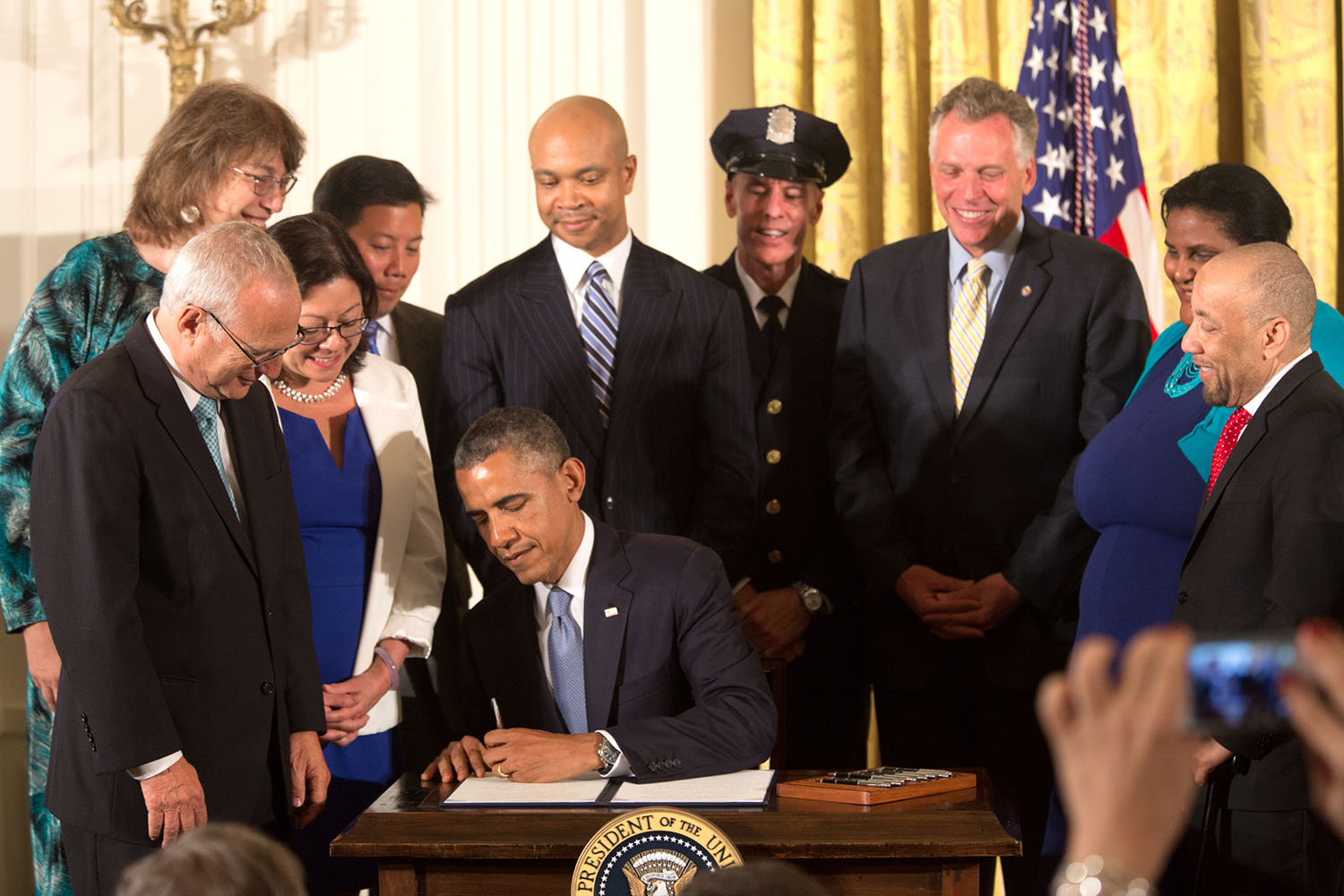
Remarks by the President at Signing of Executive Order on LGBT Workplace Discrimination
AFFIRMATIVE ACTION AND DIVERSITY
“Diversity,” as a term of art used in the context of affirmative action law and policy, gained prominence in the Supreme Court case decision of "Regents of the University of California v. Bakke. " In Bakke, the Court ruled that the attainment of diversity in university admissions was a constitutionally permissible goal. Diversity as one factor among many in higher education admissions was later upheld in the Supreme Court’s 2003 decision of Grutter v. Bollinger.
In employment, “diversity management” gained prominence in the 1990s as a voluntary effort by corporate America, unrelated to the mandatory compliance embodied in the law. Unlike the Executive Order regulations, there is no standardized method for attaining diversity. Diversity programs have different definitions and appear to vary from organization to organization.
Dr. Roosevelt Thomas, founder of the American Institute for Managing Diversity and author of Beyond Race and Gender: Unleashing the Power of your Total Workforce by Managing Diversity, argues that diversity is “any collective mixture characterized by similarities (ties that bind) and differences (differences that distinguish).” Thomas views diversity management as an evolution beyond affirmative action and its focus on race and gender.
A United Nations study on Best Practices in Diversity Management defines affirmative action as the “framework for a diversity management program.” Diversity Management means looking at: “1) the mindset of an organization; 2) the climate of an organization; and 3) the different perspectives people bring to an organization due to race, workplace styles, disabilities, and other differences.”
There are many similarities between methods used for affirmative action programs and diversity management programs. Affirmative action programs require policy statements from senior management, workforce analyses, measures of underutilization of protected groups, placement goals where necessary and action oriented programs.
CEO commitment is essential to a successful affirmative action program and senior management is required to sign the affirmative action plan for the contractor. In the 2000 amendments to the Executive Order 11246 regulations, the Department of Labor emphasized that the affirmative action program is a management tool, a diagnostic process used to promote equal opportunity, not simply a paper exercise.
The diversity management profession has grown in recent years. The position of Chief Diversity Officer (CDO) has emerged and many CDOs report to the CEOs of their corporations. Diversity managers have attained a status that most often exceeds that of the affirmative action officer. In many cases, the affirmative action officer now reports to the diversity manager.
Stony Brook University’s discussion of the relationship between affirmative action and diversity addresses the results sought by both approaches:
Affirmative action is numbers oriented, aimed at changing the demographics within the organization. Managing diversity is behavioral, aimed at changing the organizational culture, and developing skills and policies that get the best from everyone. Affirmative action opens doors in the organization while managing diversity opens the culture and the system. Managing diversity does not replace affirmative action; rather, it builds on the critical foundation laid by workplace equity programs.
Affirmative action and managing diversity go hand-in-hand, each reinforcing the gains of the other. Without affirmative action’s commitment to hiring and promoting diverse employees, organizations would rarely have the diversity of staff to reach a stage where differences are valued and diversity is effectively managed
WHY IS DIVERSITY IMPORTANT ON COLLEGE CAMPUSES?
Student bodies are no longer composed of primarily male, White students. Some estimates show that half of America’s current workforce now passes through college first and 75 percent of students in high school spend at least some time studying in a higher education setting. That number is up from an elite 4 percent in 1900. What’s more—the number of college students from low-income and minority families continues to rise. More Americans from every color and creed are now earning college educations so college faculty should reflect that. While students can certainly learn from people outside their own sex, ethnicity and belief system, faculty with similar backgrounds provide stronger role models. – Dr. Matthew Lynch
 Diversity in faculty should not only be sought out for the students’ advantage though; the college faculty as a whole benefits when many different perspectives are represented. It is important to have diversity in student populations but those groups are temporary college residents. Faculty members have the long-term ability to shape the campus culture and make it more in sync with the rest of the world.
Diversity in faculty should not only be sought out for the students’ advantage though; the college faculty as a whole benefits when many different perspectives are represented. It is important to have diversity in student populations but those groups are temporary college residents. Faculty members have the long-term ability to shape the campus culture and make it more in sync with the rest of the world.
As AAAED's Distinguished Scholar William B. Harvey wrote:
“The prospect of the court dismantling a policy that works should disturb and compel action among all higher education leaders. They’ve seen as well as I, as the former chief diversity officer at a leading university and founding president of the national professional association of diversity officers, how diversity enhances the learning environments for all students and improves the quality of education at institutions where affirmative action policies have been embraced.” Case Currents, July/August 2012
While nearly 30 percent of undergraduate students around the nation are considered minorities, just over 12 percent of full-time faculty are minorities. That number drops to around 9 percent for full-time professors of color. Though half of all undergraduate students are women, roughly one-third of full-time professors are women. In 1940, the number of women faculty was at 25 percent, showing just how slowly this particular minority group is climbing. The numbers are going in the right direction, but not quickly enough.
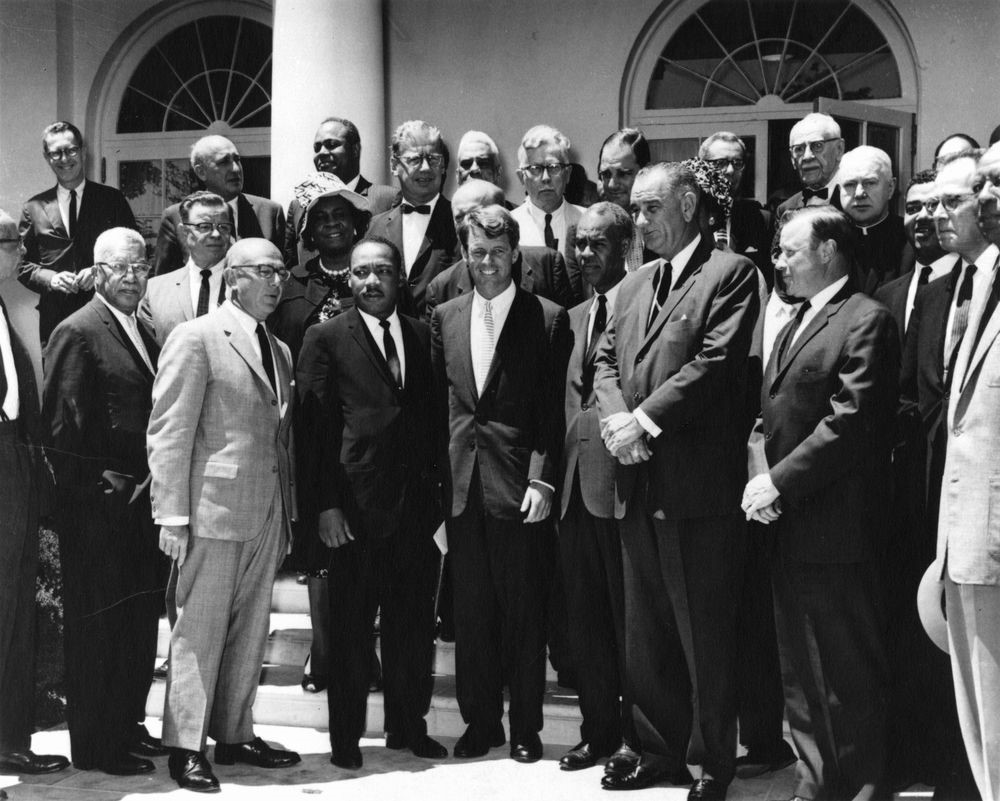
President Kennedy and Robert Kennedy meet with civil rights leaders
AFFIRMATIVE ACTION AND INCLUSION
Never has it been more critical to understand the engine that "compliance" is for the diversity bus we collectively drive. Affirmative Action has many meanings to many people, but stripped of words heavy with hidden meaning and agenda on all sides of the issue, it is about action. It's about taking positive action steps, reaching out action steps---affirmative, positive action steps.
It is a call to use some "elbow grease" to achieve, first, the representational diversity in the workforce (and our student body) we all seek. Using that "elbow grease" entails attending to multiple details, to look at all the trees as well as the whole forest to help bring in people from all different backgrounds---and it requires action,--- active thinking and then action,--- to "deal with"; "to manage"--plan for, build planning and strategies around---the very diversity we bring in.
These multiple details include reviewing policies and procedures--actively---to see where they help or where they hinder our representational diversity. .--this kind of review, if affirmative, if action oriented, can be one foundational element to rooting out systemic issues of discrimination and is part of "diversity" in action.
These multiple details include reviewing what we do when problems arise that will drive people away, reduce perhaps our representational diversity---we are not defined by what happens, we are defined by how we handle it.: and never has this been made clearer to us since April of 2011 when all of us, every institution of higher education were told we were NOT dealing with sexual violence, with rape, against women correctly or effectively. It is active and it is affirmative of our communities to take action, do investigations, and speak up quickly, etc., when "bad things" happen. AND MOST IMPORTANT, to take action to identify the areas of culture and climate that need attention---need elbow grease---need action to change. We use the outcomes of investigations actively to analyze what some of the framing is, systemic issues perhaps, etc., and then determine best practices to address what we learn so that our diverse communities can be one in which all thrive, feel included, listened to, attended to when bad things happen.
Affirmative Action is a key element of the "inclusion" framework: positive, affirming action is required to make sure all feel included---welcome, wanted, accepted, respected, partnered with for success and present at all input and decision making tables.
It is active and it is affirmative--it takes action, elbow grease and the will and the commitment to have diversity dialogues--diversity dialogues themselves are a type of program, an affirmative action program. --Dr. Carmen Suarez
WHY DO WE NEED AFFIRMATIVE ACTION?
Affirmative action is the responsibility of all managers, not only the human resources or multicultural departments. Managers should actively recruit, even when there are no vacancies or when someone is not in the job market. Identify the “stars.”
Affirmative Action is consistent with the principles of merit. Affirmative Action and Excellence are not mutually exclusive terms. Excellence comes in all colors and genders.
As President Clinton stated: “Affirmative action is an effort to develop a systematic approach to open the doors of education, employment and business development opportunities to qualified individuals who happen to be members of groups that have experienced longstanding and persistent discrimination.” Where there is more affirmative action, there is less discrimination.
The Nation’s Demographics are changing.
 On May 17, 2012, the United States Census Bureau reported that “Most Children Younger than Age 1 Are Minorities.” The New York Times put it more simply: White births are no longer a majority in the United States.” “ Non-Hispanic whites accounted for 49.6 percent of all births in the 12-month period that ended last July, according to Census Bureau data made public on Thursday, while minorities — including Hispanics, blacks, Asians and those of mixed race — reached 50.4 percent, representing a majority for the first time in the country’s history”, wrote the Times.
On May 17, 2012, the United States Census Bureau reported that “Most Children Younger than Age 1 Are Minorities.” The New York Times put it more simply: White births are no longer a majority in the United States.” “ Non-Hispanic whites accounted for 49.6 percent of all births in the 12-month period that ended last July, according to Census Bureau data made public on Thursday, while minorities — including Hispanics, blacks, Asians and those of mixed race — reached 50.4 percent, representing a majority for the first time in the country’s history”, wrote the Times.
This is a significant event, long predicted by demographers – a milestone in this nation’s history. Overall, whites will remain the largest population for some time, accounting for 63 percent of the population. The birth data augur a longer-term future that will be quite different from the country founded by Europeans. In the words of one demographer, the United States is becoming a more “globalized, multiethnic country.” Whites are no longer the majority in four states and the District of Columbia and are less than half of the population in major cities including New York, Las Vegas and Memphis.
Hispanics are the fastest-growing minority group, numbering 52 million in 2011. They constitute 16.7 percent of the population and grew by 3.1 percent since 2010. African Americans are the second-largest population of color, numbering 43.9 million in 2011 (up 1.6 percent from 2010). Asians are the second-fastest growing group, increasing by 3.0 percent since 2010. Asians numbered 18.2 million in 2011.
The U.S. Census Bureau projects that by 2043 the minority population is projected to become the majority. The agency bases its projections on the 2010 census. In the report the agency projects that the population will grow more slowly, continue aging and become more diverse. In 2032 the net international migration will overtake its natural increase as the driver of our population growth.
“In order to get beyond racism, we must first take account of race. There is no other way,” wrote Justice Harry Blackmun in Bakke. A positive program of nondiscrimination will be needed as long as there are racial, gender and other disparities in contracting, higher education admissions and employment. The tent has widened since the 1960s and now includes successive movements for women, ethnic minorities, individuals with disabilities and the LGBT community.
Why do we need Affirmative Action? Because simple fairness demands it. The nation’s future requires it.